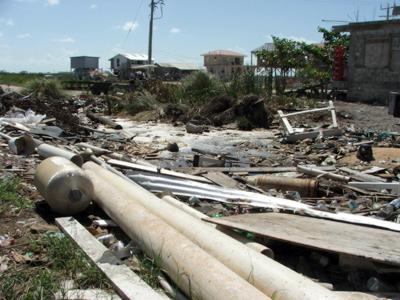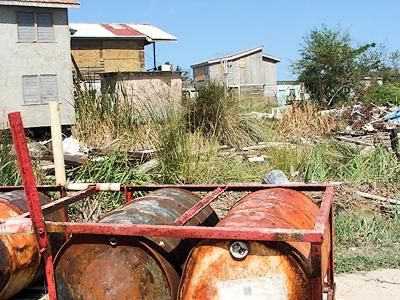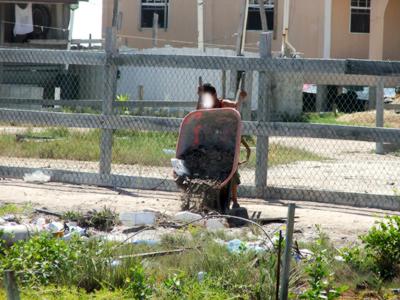 |
Improper disposal of garbage is everyone’s problem.
|
 |
Garbage finds its way to our water systems.
|
 |
Anything from construction materials to water heaters are found at these sites.
|
 |
Illegal dumpsites affects the health of people that live close to those areas.
|
 |
Containers such as these may contain gases which damage a person’s health, even by simply smelling it over a period of time.
|
 |
Anyone caught disposing of garbage is liable to receive a ticket.
|
It is estimated that Belize produces approximately 300,000 tons of solid waste annually from domestic households and commercial establishments. This means that each person living in Belize produces approximately two to three pounds of solid waste every day.
With so much garbage, illegal dumping has become a serious and growing problem on our island jewel, San Pedro. Abandoned garbage is not only an eyesore, but the sites that are not cleaned up can lead to a number of health and safety concerns, which fosters a negative image to any community. Improper disposal of garbage is everyone’s problem. Are we all disposing of our garbage properly or are we ‘dumping’ our garbage improperly? Or are local authorities and central government providing only a limited sanitation service? Regardless of who is to blame, we are now faced with an enormous challenge that not only poses a threat to our health, but to our precious water system which is being polluted by the toxic chemicals seeping from the garbage. It has been said that “land is the reflection of water,” however, are we doing our part to make sure our land looks as pristine as our Caribbean waters?
An assessment on the island shows a significant amount of garbage piles near or around various residential areas within town. Not only are people breaking the law when they chose to dump their garbage at these sites but a closer look in the San Pedrito area shows that people, regardless of all the health effects posed, find themselves carrying on their day-to-day lives in close proximity to these disease prone sites. Some residents living near or around the dumps have complained about the health risks which they are being exposed to. Some residents, who chose to remain anonymous, stated to The San Pedro Sun that one of the more significant dumps, next to a newly opened pre-school, has been growing as the months go by. “Our calls to the officials have gone unanswered and the garbage pile just keeps growing and growing,” they stated.
Residents comment that dumping of more garbage at other various piles continues as the days go by. However, it is worth mentioning that these illegal dump sites are not only found in what may be classified to be the poorer neighborhoods, but are also found to the North, before getting to the bridge, and even to the South of the island. The situation not only creates an eyesore but is also a health hazard to the families and children that are found around the ever-increasing areas. A closer look at the various items found in these dumps show the hazardous materials found within; including aerosol bottles, medical wastes, needles, refrigerators, sofas, stoves, water heaters, car liquid wastes and even butane tanks.
Clean-up: Whose responsibility is it?
The San Pedro Sun’s Volume 16 Number 51 issue, dated December 28th, 2006 entitled “Garbage – A messy problem”, tackled the same illegal dump site issue. Coincidentally, what sparked the concern over these dumps, were the various complaints being received at our offices about the same dump next to the newly built pre-school.
At that time, The Sun held an interview with Town Administrator Patricia Verde, where she stated that the dumps were a Health Department issue, to be handled by the island’s Health Officer and as such were not a jurisdiction of the San Pedro Town Council.
However, an interview with Albert Roches, Environmental Officer for the Department of Environment (DOE), gave The Sun some insight on the environmental laws of Belize in regards to pollution and waste management. According to Roches, DOE is the only authority to designate the areas which are to be used for dump sites. And whilst DOE designates the areas, the San Pedro Town Council is responsible for monitoring the areas so that they won’t threaten the lives of residents.
Illegal Dumping occurs when generated waste is disposed at any given location without being granted legal permission. Garbage is currently being disposed of at dumps that are inappropriately sited throughout the country, in backyards or by illegally dumping along road sides, empty lots, sea shores, river banks and other environmentally sensitive areas. A common practice throughout the country is the use of garbage as landfill in low laying areas or lots. However, since 1996, that environmental act was revised and this practice was deemed “illegal.” It is illegal to dump solid waste such as trash, garbage, appliances, furniture, pallets, yard waste, tires and any type of construction and demolition material such as roofing materials, structural lumber, windows and doors.
What action is the San Pedro Town Council taking to address these concerns? The Sun placed calls to officials at the Town Council and learned that they are currently in training for processing tickets to people who are caught doing these acts. Roches stated that anyone caught disposing of garbage in an unauthorized site may receive a littering ticket. The issuance of tickets is entirely new to the offices of the San Pedro Town Council but once fully trained, council members, staff and other entities and individuals around town will issue these to any offender. However, one must make the following mental note: Any item that can be traced to any one individual or company and if found within these illegal dumpsites will be held fully responsible for this punishable act. Strong enforcement measures against these law breakers will be in effect and include penalties and fines which may be $100 per individual and $500 per company. Once these tickets go unpaid, court action may be taken against the criminals.
Health Concerns
Not only do these illegal dump sites cause a heightened risk of physical injury from contact with broken glass, sharp metal and other waste trash but garbage brings with it a host of diseases and dangers. The ideal milieu for rats, mice and other rodents, ticks, flies and mosquitoes are garbage and in many cases these transmit diseases to human beings. Plague is perhaps the most well-known rodent-vectored disease, due to the enormous impact it had on the human population of Medieval Europe when it was referred to as the Black Death. Although plague still exists and kills people in many parts of the world, other rodent transmitted diseases such as Lassa Fever and Leptospirosis are perhaps more serious in the numbers of people infected. There is growing concern from many experts around the world that zoonotic diseases (caused by infectious agents that can be transmitted between or are shared by animals and humans) are emerging and re-emerging, particularly in developing countries that lack the resources to investigate, manage and treat a number of diseases and the underlying reasons for their spread and persistence.
Sewage is a mixture of water, human waste, and ground-up garbage, although domestic sewage is about 99.9 per cent liquid and one per cent solid such as soiled diapers. The water and human waste contents come from sinks and toilets of homes (from bathtubs, showers, dishwashers and laundry washers), restaurants, and office buildings. Untreated sewage is host to bacteria responsible for various infectious diseases. Some diseases transmitted by untreated or improperly treated sewage are typhoid, paratyphoid, cholera, dysentery, gastroenteritis and infectious hepatitis (jaundice). Disease-causing bacteria can contaminate drinking water supplies and be transported by flies, rodents and dogs. Improperly disposed-of solid waste, which includes everything from bottles to plastics, appliances, oil drums and aluminum cans, may be a direct source of disease as organic material could pollute surface and ground waters that are used as drinking supplies, as well as spread disease through rats, mice and flies.
Decaying garbage and yard waste not only create unpleasant odors, but many of the materials that are dumped contain toxic or hazardous substances that could threaten water supplies. Illegal dumping of household and commercial waste has a variety of impacts on water quality. Hazardous chemicals generated from household, commercial and industrial sources can contaminate ground and surface water supplies, affecting drinking water and public health as well as aquatic habitat.
While visiting the various dump sites, The San Pedro Sun noted four large oil drums/containers, however they were not necessarily dumped in the site but rather abandoned on the side street in front of the site. Whether these drums contain oil or gasoline is not known but gasoline poses a serious health risk. Breathing small amounts of gasoline vapors can lead to nose and throat irritation, headaches, dizziness, nausea, vomiting, confusion and breathing difficulties. Symptoms from swallowing small amounts of gasoline include mouth, throat and stomach irritation, nausea, vomiting, dizziness and headaches. Swallowing gasoline causes accidental poisonings and some effects of skin contact with gasoline include rashes, redness and swelling. Being exposed to large amounts of gasoline can lead to coma or death, not to mention the fire hazard it poses.
The health effects of being exposed to gasoline over long periods of time are not well known. This is because people exposed to gasoline are usually exposed to many other things that also can cause health effects. Some workers who are exposed to gasoline everyday in their jobs have suffered memory loss and impaired muscle function. At very high levels, some of the chemicals in gasoline, such as benzene, are known to cause cancer. Current evidence, however, does not show that exposure to low levels of gasoline causes cancer in humans.
Batteries which may be seen in these sites – coming from typical sources, such as cell phones, pagers, cameras, computers, flashlights, power tools, research equipment, monitoring devices, health monitors, lanterns, burglar alarms, emergency light batteries...and the list goes on – contain poisons such as mercury which can seep through the soil and contaminate the ground water. Keeping batteries away from small children is essential. All batteries are now classified as “hazardous waste.” Batteries have been determined to be unsuitable for disposal as municipal solid waste because they contain toxic heavy metals and have corrosive properties. Batteries are not to be placed in waste baskets or dumpsters where they will end up as municipal trash. Check with the San Pedro Town Council as to how they are collecting such wastes.
What to do?
Albert Roches ended by saying that if illegal dumping problems are not reported, the problem often grows. “Once a pile begins, it often seems to take on a life of its own by inviting other people to pile on additional wastes including hazardous wastes such as household hazardous wastes (batteries, oil, paint, and antifreeze), commercial and industrial wastes, and other regulated or illegal substances,” he concluded. Help “La Isla Bonita” significantly reduce illegal dumping by reporting illegal dumping activity and working together with the San Pedro Town Council officials and law enforcement agencies for a cleaner, healthier, and safer community. To make a report, contact the San Pedro Town Council office at 226-2198 or Department of Environment at 822-2816.
Become a part of the cure and not the problem!

|





